Fascinating Capital City
If you are interested in experiencing a vibrant city of the Canadian west, then you have to pay Edmonton a visit
Edmonton is the capital city of the Canadian province of Alberta and the northernmost major city in Canada. You can easily spend a couple of days in town as there is plenty to see and it has a lot of interesting history in spite of being a young city.
It’s located relatively close to Jasper National Park so if you have time while visiting, it is highly recommended that you go on an excursion to Jasper to explore this amazing nature preserve.
The First Nations People & the Fur Traders
Before the Europeans arrived the plains were filled with bison migrating to the North Saskatchewan River. There were a lot of beavers, muskrats and deer in the area. Also grizzlies, wolfs and elks were present.
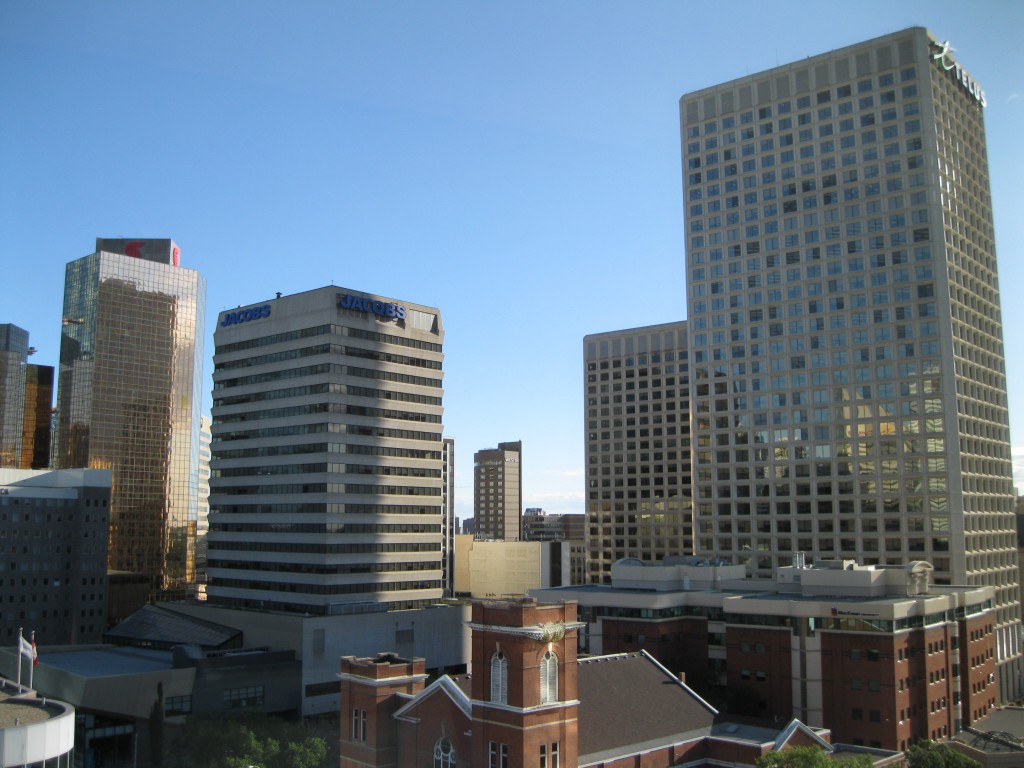
The First Nations People had recognised the potential and the beauty of the land and had been regular visitors for centuries. The first European settlement was in the area known as Beaver Hills located just east of present day Edmonton. The very first structure was a trading post called Beaver Hills House. The spot was convenient as it was close to the hills and the trapping grounds.
The Cree Indians had established themselves along the North Saskatchewan River and by the early 1700s their future was closely tied with the European fur traders. They had based themselves here by setting up fur posts which were the basis for the first industry in the area.
The fur trade dominated the development of the western lands for two centuries and created a bond between the First Nations People and the Europeans. Many traders married Indian women who played an essential role in the industry. The First Nations People therefore became trading partners and did a lot of the difficult work to ensure survival in the harsh wilderness.
Anthony Henday – The First Fur Trade Explorer
Anthony Henday was the first fur-trade explorer sent this far west by the Hudson’s Bay Company and passed near where present day Edmonton is located in 1754. The purposed of his trip was to establish direct contact with the native people to avoid the dealing with native middlemen to bring furs to posts based on Hudson’s Bay. This change in policy was due to competition from free traders and the Montreal based North West Company.
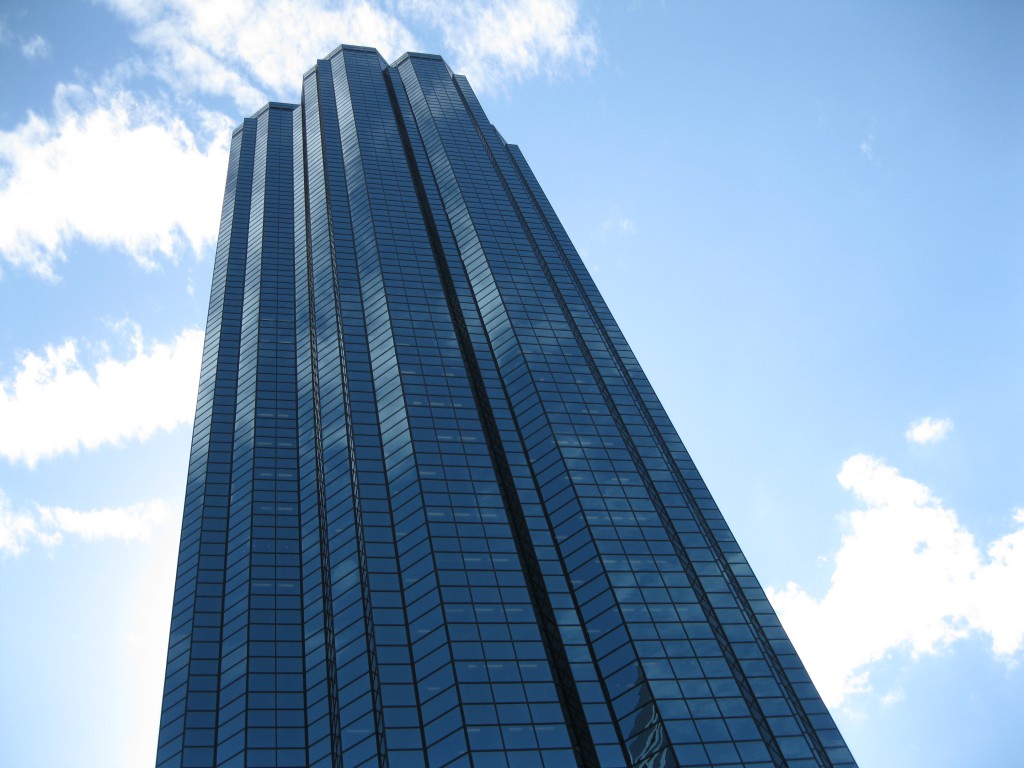
The land was foreign to Henday and he learned from the culture of the First Nations People he met who taught him how to survive in the harsh environment. He would rely upon them as he moved further into the land. This arrival signalled new times for the First Nations People.
The Hudson’s Bay Company & the North West Company
Throughout the 18th century the Hudson’s Bay Company and the North West Company would establish posts in the west along the North Saskatchewan River Valley in search of new supplies for fur.
In 1795 the North West Company constructed a post called Fort Augustus on the site where present day Edmonton is located. The Hudson’s Bay Company built a post nearby which would be called Edmonton House named after an estate close to London in England.

Both companies employed a lot of French Canadians and French speaking Métis in the early years so French was the most common language spoken. The two companies merged in 1821 and the post of the Hudson’s Bay Company was retained together with the name Fort Edmonton. The North West Company’s link to Montreal was terminated.
The Change of Life and the Establishment of a Capital
Rupert’s Land and the Northwest Territories were purchased from the Hudson’s Bay Company and transferred to the Dominion of Canada during 1869-1871. This resulted in the government determining the way of life as opposed to the fur trade.
After 1870 as the area had become a part of the Dominion of Canada, the character of the area started to change. It became possible for private individuals to claim land which previously had been preserved for the Hudson’s Bay Company. Shortly after, Edmonton began to become an entity and separated itself from the fort.
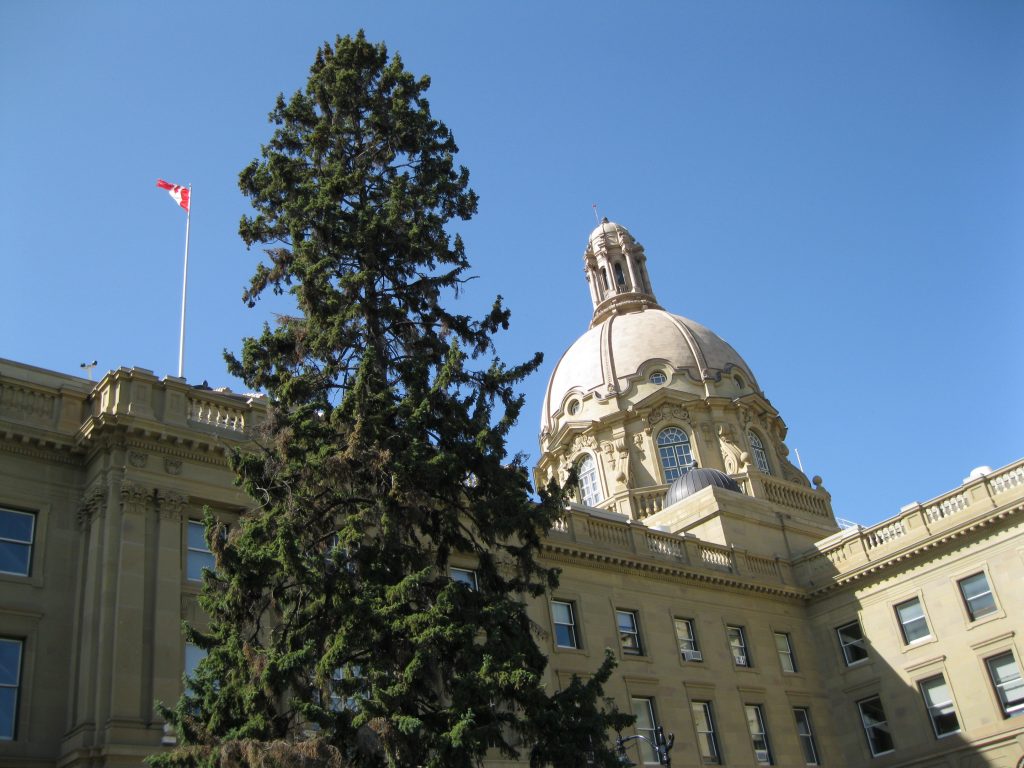
This period of western exploration led the way for mapmakers and traders such as Peter Pond, David Thompson, Alexander Mackenzie and Simon Fraser who would leave their mark on the area. The North West Mounted Police arrived in 1874 and they were an important factor in the establishment of European culture in western Canada. They would ensure the stability which would allow for the signing of the treaties between the First Nations People and Canada.
By 1880 a lot of English settlers had arrived and the Métis and French speakers were outnumbered.
The Métis were huge part of the exploration, fur trade, freighting, bison hunting and general commerce on the plains as well. They helped shaping the direction of western Canada for decades. The First Nations People adjusted to the change the Europeans brought via commerce and settlements.
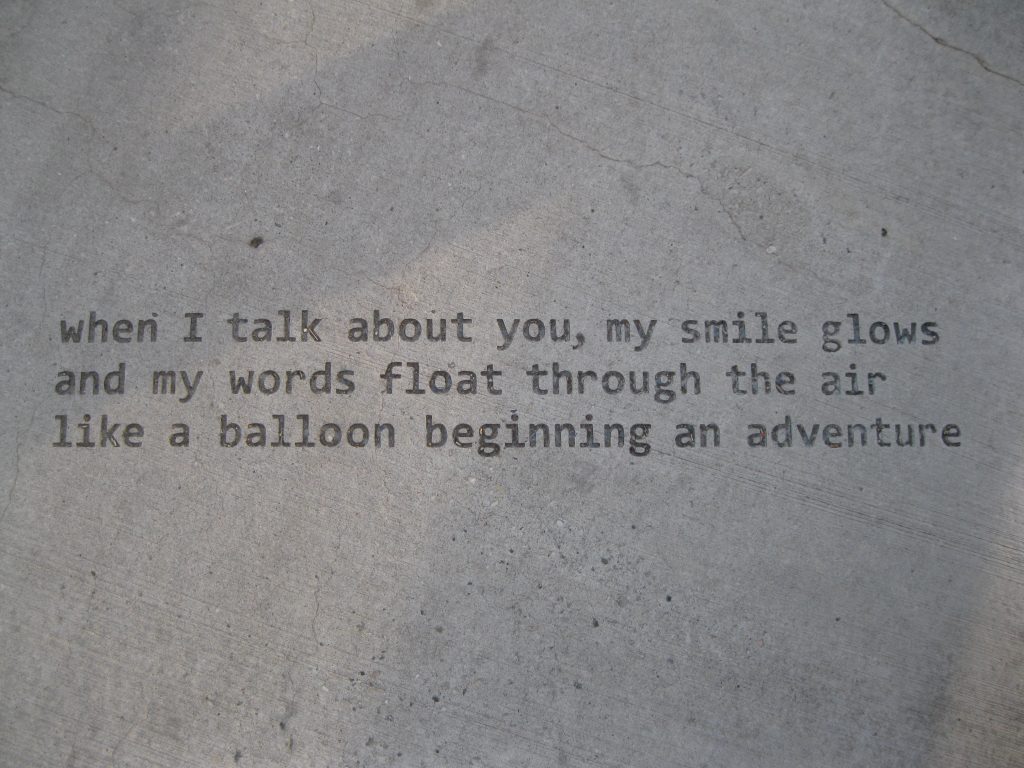
By 1892 Edmonton was incorporated as a town and in 1904 it became a city. The Province of Alberta was proclaimed in Edmonton in 1905 and after a brief campaign the city was chosen as the capital in 1906. It was a lively city before the First World War. In 1901 the population was 2,626 and by the beginning of the war in 1914 it had expanded to 30 times the size.
The Growth of the City
In 1891 the Calgary and Edmonton Railway reached the south bank of the river. The community of South Edmonton quickly grew which would later become the city of Strathcona in 1908. It was established just across the North Saskatchewan River and in 1912 it was merged with Edmonton to become Greater Edmonton.
The Hudson’s Bay Company had sold much of its land which was used to develop downtown Edmonton. Ferries and later bridges were used to transport trade across the river. In 1902 the Low Level Bridge was completed and the High Level Bridge in 1913. The Athabasca Landing Trail connected the area with northern resources during the Klondike Gold Rush and the fur trade.
The Natural Resources
Edmonton was situated in an area with a great quantity of natural resources such as coal and petroleum. Coal and wood fuelled the local industries. Later coal fed the railways which also boomed the economy during the early 20th century. Homes and businesses were warmed by coal from the many mines in the areas. There were more than 30 mines by 1908.
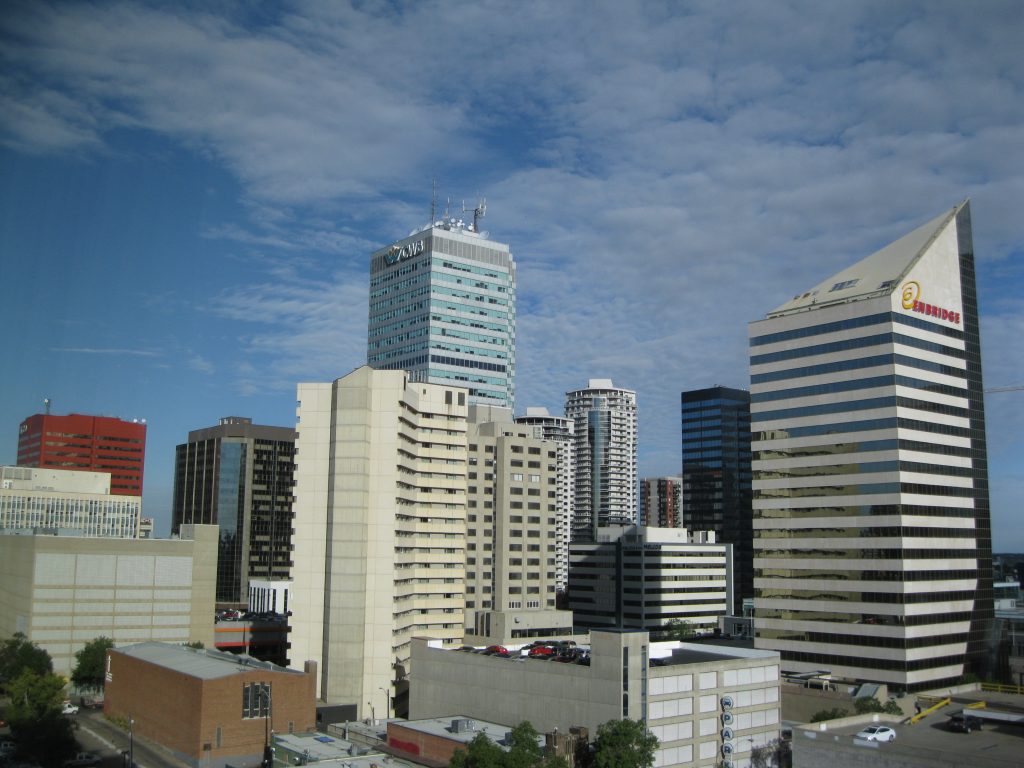
Agriculture sparked regional prosperity and a lot of immigrants arrived to Edmonton from 1896 to 1913 from other parts of Canada, the United States and Europe who were attracted by the fertile farmland.
The Gateway to the North
In 1918 the Canadian flying ace from the First World War, Wop May, opened an aviation company at Blatchford Field which would be the first municipal “air harbour” in Canada. This became the jumping off point for the opening of the great northern resource frontier after the First World War. This established Edmonton as the gateway to the North and having the first municipal airport paid huge dividends to the city.
Property Rights
In the early days, Squatter’s rights would often determine the ownership and the transfer of property was simply done by the handshake between two settlers. The land became available for private purchase in 1882 and the first land sale was by the Hudson’s Bay Company. From then on real estate became a commodity. During the 20th century three railways arrived which brought more settlers to town as well. It secured Edmonton a great position in the market as a supply centre for the expanding oil and gas industry.
The Discovery of Oil…the Natural Resources Continued
After the Great Depression and World War II, oil was discovered in Edmonton in 1947 which sparked a cycle of new growth in town. Due to the prospect of well-paying jobs a lot of people came to northern and central Alberta. Oil quickly surpassed agriculture as the main industry of growth of town. The following half century the oil and gas industries shaped Edmonton. As a result the population doubled from 113,000 in 1946 to 226,000 in 1956. By 1966 the city had doubled in size in comparison with 1947.
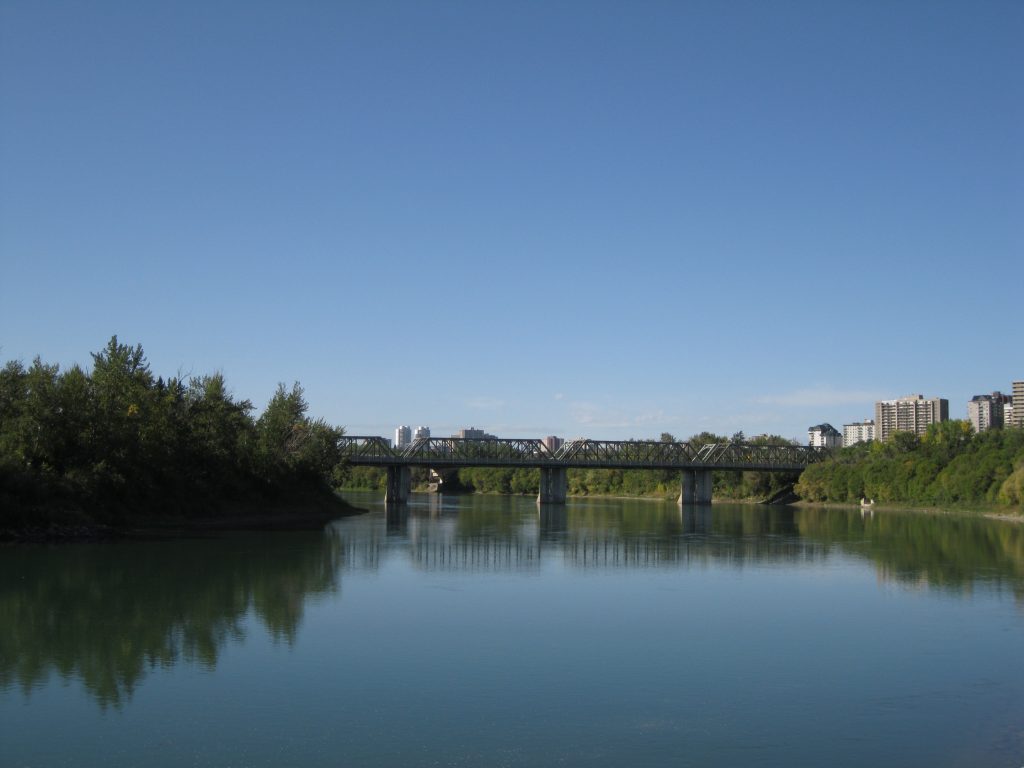
Edmonton was built on natural resources, first the fur trade, coal and other industries dominated the area and then lumberyards, brickyards and slaughterhouses came to use raw materials from the area around the North Saskatchewan River to build the growing city and feed the increasing population.
The Diversified Culture
Edmonton prides itself on its diversified culture and is known as the Festival City. This is because of the long tradition of festivals and celebrations in the city such as the Edmonton International Jazz Festival, the Edmonton Folk Festival, the Summerfest which has art events and the Works which celebrates the visual arts.
Procol Harum & the Edmonton Symphony Orchestra
The English rock band Procol Harum and the well-respected Edmonton Symphony Orchestra made music history when they collaborated in 1971.
Procol Harum band leader Gary Brooker had always had the ambition to perform with a symphony orchestra, but guitarist Robin Trower did not like the idea. In the summer of 1969, the band was asked to perform at the Stratford Festival in Ontario with an orchestra. Brooker wrote the orchestration and choir parts for a progressive piece from the “Shine on Brightly” album from 1968 called “In Held ‘Twas In I” which they performed and it was a success.
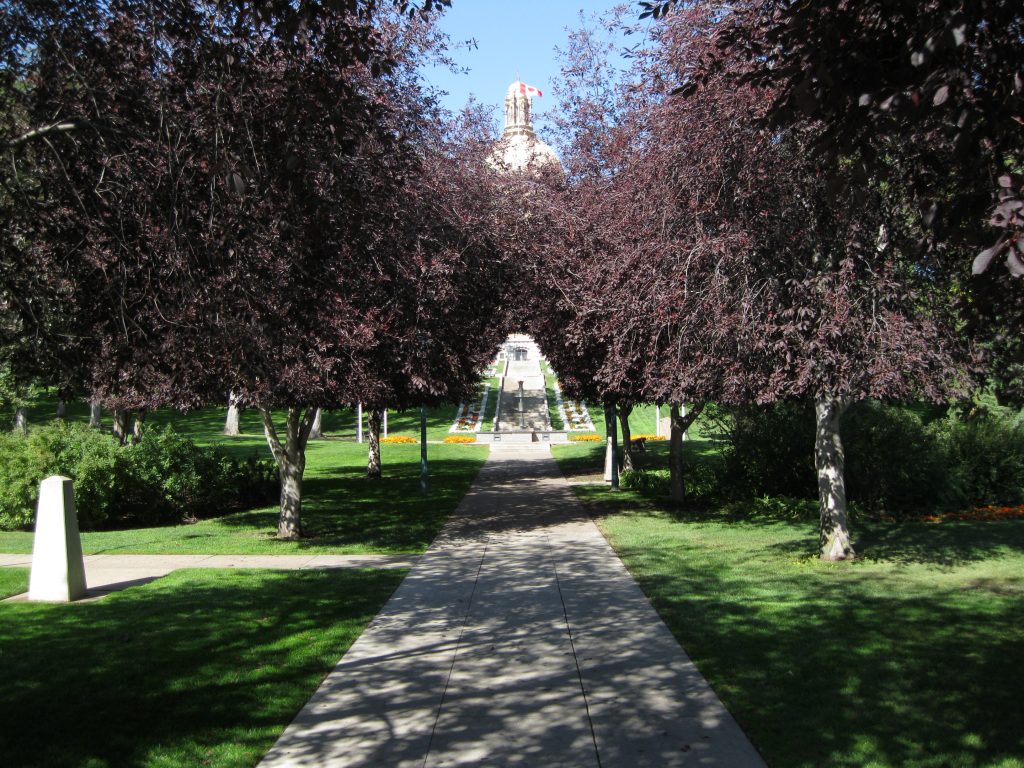
This took place before Deep Purple did their famous “Concerto for Group and Orchestra” performed on 24 September 1969. Their recording was released in December 1969 and was the first ever recorded combination of a rock band and a symphony orchestra
The word spread about their orchestral performance and Procol Harum were then invited to play with the Edmonton Symphony Orchestra. Robin Trower was opposed to the concept, left the band and was replaced by Dave Ball. The concert was held at the Northern Alberta Jubilee Auditorium in Edmonton on 18 November 1971 along with Da Camera Singers. A live album was recorded at the event called “Procol Harum Live: In Concert with the Edmonton Symphony Orchestra” which was released the following year.
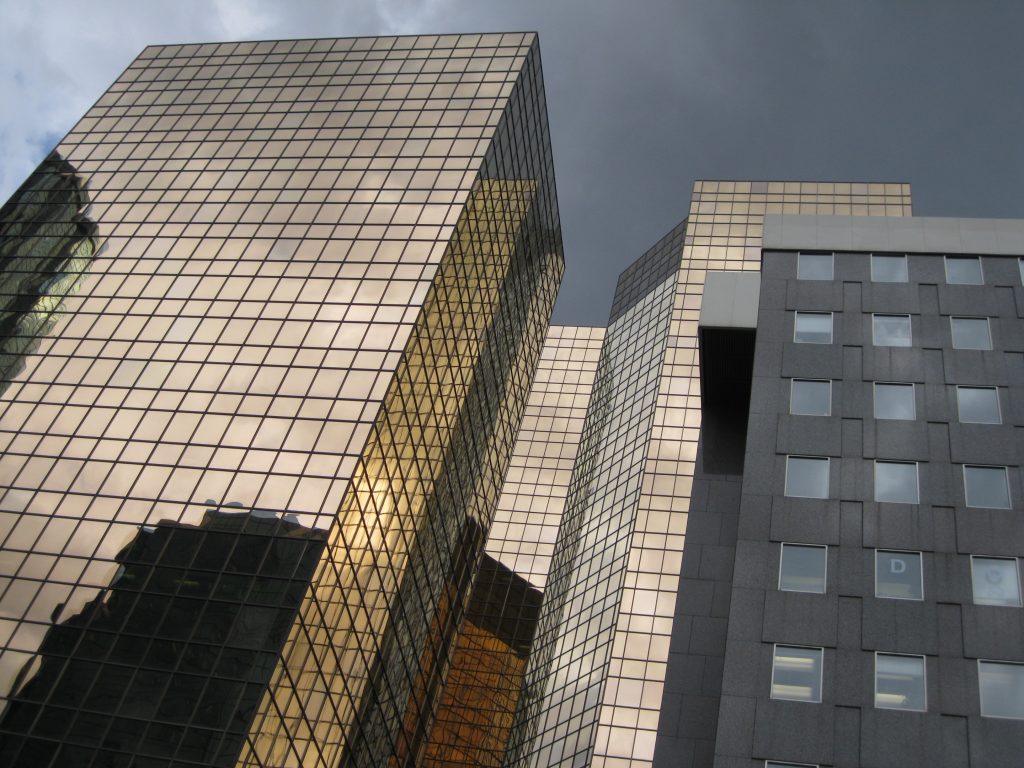
The event was a great success. It was Procol Harum’s most successful album reaching number 5 on the American Billboard charts. It was the first album with an orchestra to reach gold status, and later platimum, also a first. The single for “Conquistador” peaked at number 16 and became their biggest hit in North America.
Procol Harum have since performed symphony orchestras on several occasions and reunited with the Edmonton Symphony Orchestra in 1991 to mark the 20th anniversary.
The Pedway
As you walk around town you will notice that Edmonton like Calgary has overground passages between the major buildings in Downtown as opposed to underground pathways as in Toronto and Montreal. In Edmonton this is called the Pedway.
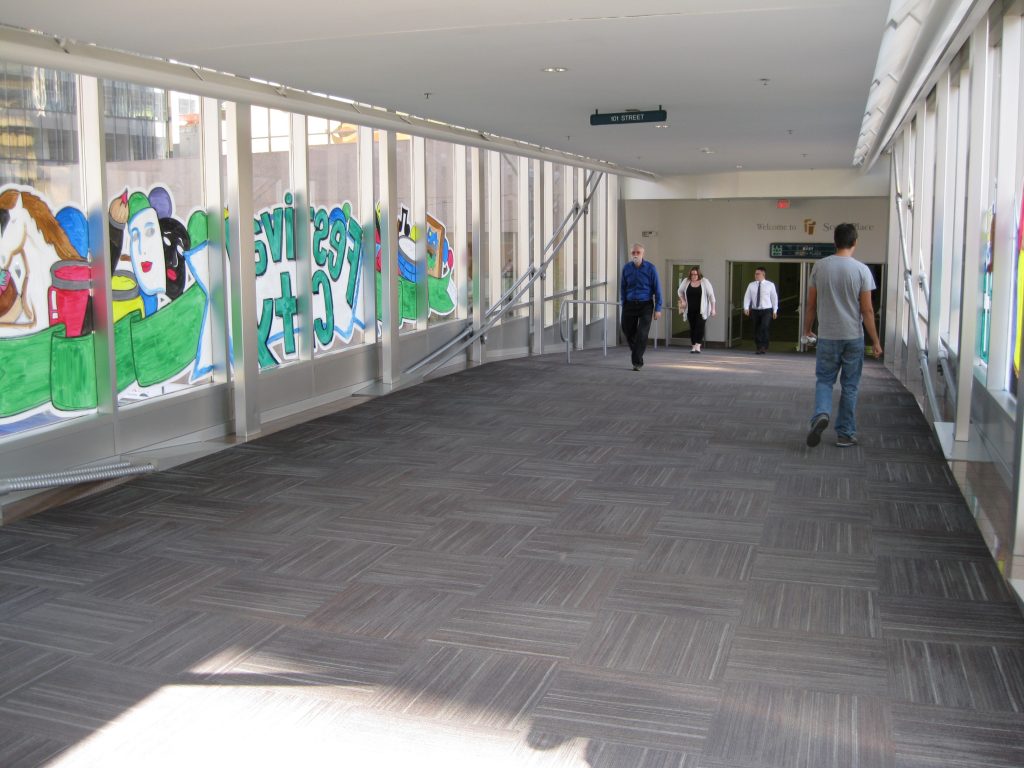
The network connects office buildings, shopping malls and parkades, consisting of 13 km (8.1 miles) of tunnels and walkways between 2nd floors of buildings approximately 4.6 metres (15 ft) above street leve. The system is climate-controlled throughout the year.
Walking around these Pedways is a pretty neat way of exploring the city as you will be able to view the streets and buildings from the pathways. Along the way there are shops and you may also enter shopping malls such as Edmonton Centre.
The North Saskatchewan River Valley
Going back in geological history. The North Saskatchewan River Valley had changed continuously since the retreat of the last continental ice sheets. The deep valleys have been carved by floods for thousands of years ever since and created the beautiful scenery.

The North Saskatchewan River Valley is one of the highlights of town which is the largest urban park in North America. It offers year around access to trails for outdoor activities such as hiking, jogging and biking.
It is a part of what is officially known as the North Saskatchewan River Valley Parks System, also nicknamed “The Green Ribbon”, and is a continuous collection of urban parks along the valley of Edmonton. This parks system has 11 lakes, different walking trails and camping-like facilities.
It’s a major ecological corridor across Edmonton and is important to biodiversity in Alberta. There are many different species of animals in the park system and it is the passage for a lot of wildlife. The river valley supports natural processes like decomposition and seed dispersal which helps preventing floods.
Rogers Place
A new stadium has been built for the local hockey club the Edmonton Oilers in the ICE District, called the Rogers Place. It replaced the legendary venue Rexall Place a bit outside the city at 7424 118 Avenue, now known as the Northlands Coliseum.
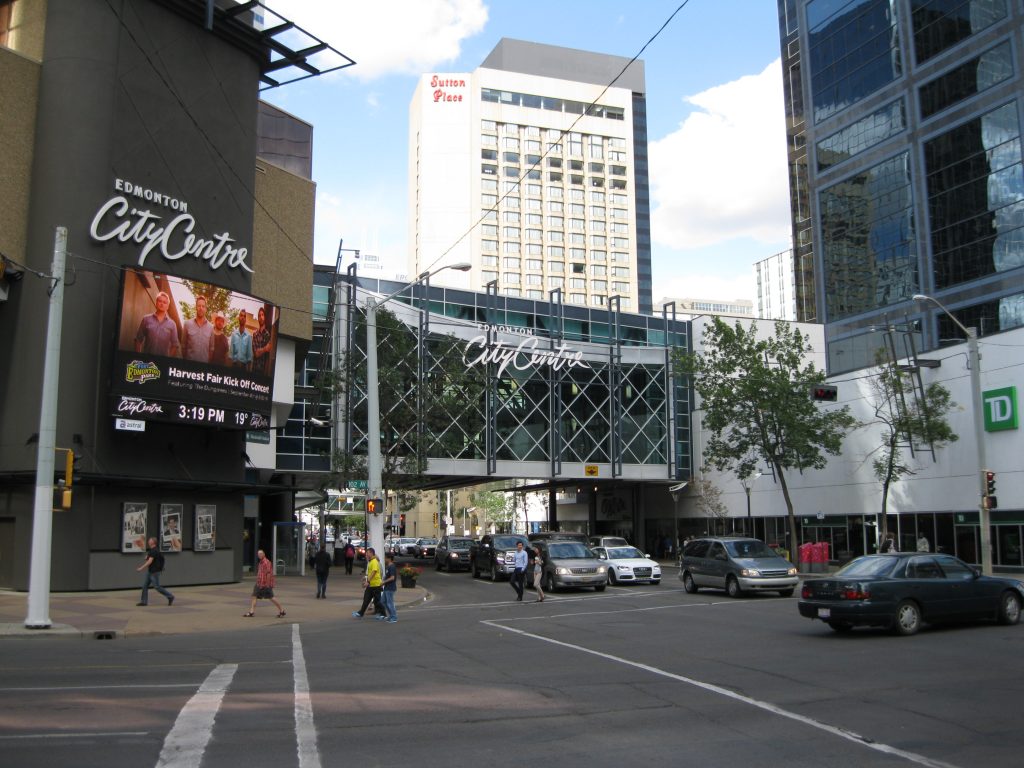
Rogers Place is a multi-use indoor arena that opened on 8 September 2016. It’s mainly used for hockey but can also be converted to a concert venue and for other events. The capacity is 18,347 people for hockey and 20,734 people for concerts.
Edmonton Oilers
The Edmonton Oilers are the pride of the city. The club was founded in 1971 and had great success in the 80’s where players like Paul Coffey, Mark Messier and especially Wayne Gretzky were the big stars of the time. They won the Stanley Cup five times and were honoured in the Hockey Hall of Fame in Toronto for their success in the 1980s.
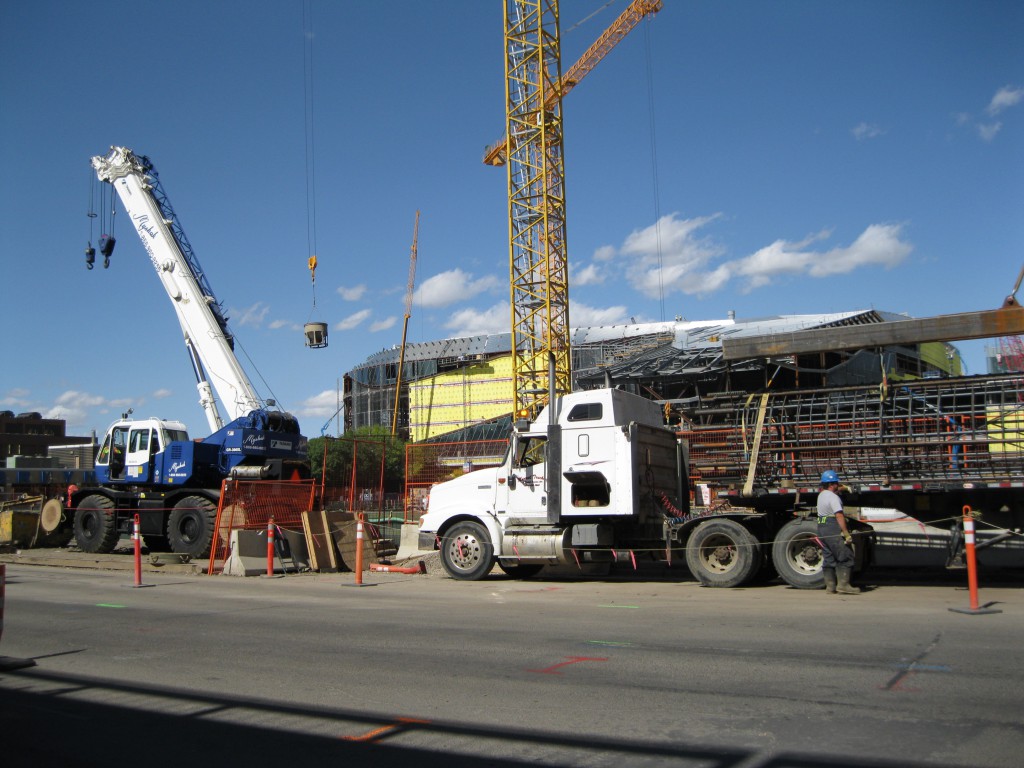
Things are a bit different these days which out a single Stanley Cup trophy since 1990 but you cannot deny the unique history of the club and it is a well-respected team. For many people when you think Edmonton, the first thing that comes to mind is Edmonton Oilers due to the legendary 80s team. They have made quite an impact.
At the Kingsway Garden Mall in Northwest Edmonton you can pay the official Oilers Store a visit. They have a lot of cool accessories. This merchandise is as always very expensive though.
Edmonton City Hall
The Edmonton City Hall building is located on Sir Winston Churchill Square in the heart of Downtown and is a postmodern structure reminiscent of the pyramid at the Louvre in Paris. It features two glass and steel pyramids, one 43 metres (141 ft) high on top of a three storey tall concrete building fronted by a big fountain which is converted to a ice rink during winter.
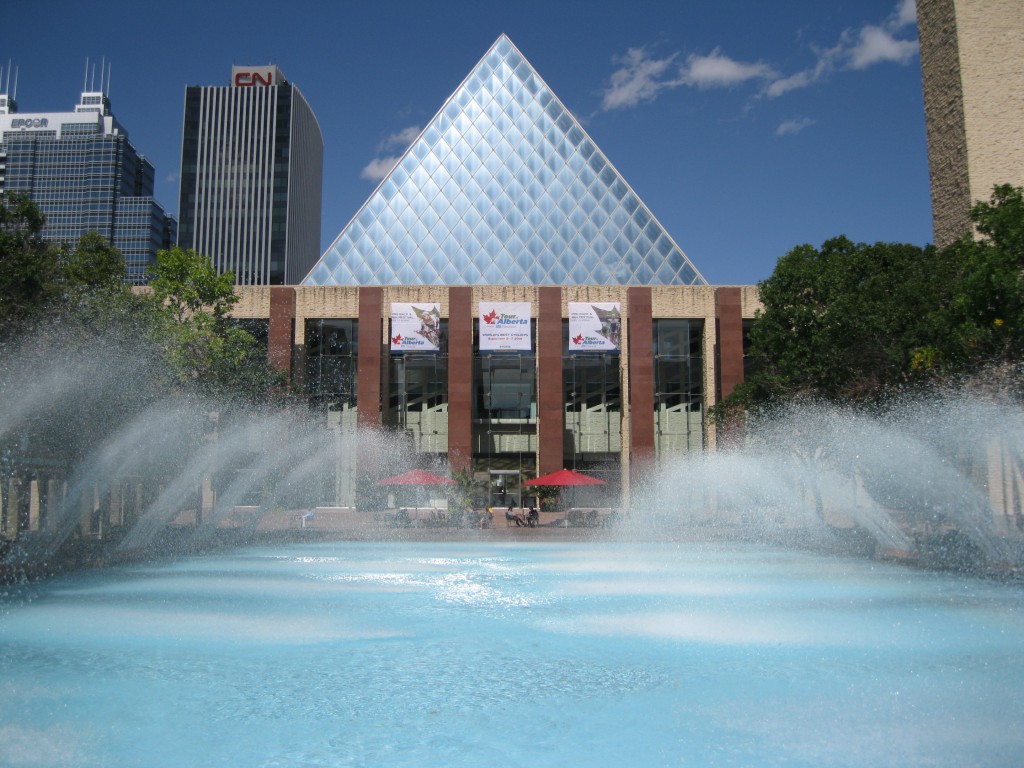
The pyramids were designed to resemble the peaks of the Rocky Mountains. Visiting the square is really nice as you will have the view of the beautiful fountain fronting the great design of the city hall. Nearby right across the street, you’ll have the vista of the intriguing Art Gallery of Alberta stands tall amidst the high rise buildings of Downtown
The Art Gallery of Alberta
The Art Gallery of Alberta, at 2 Sir Winton Churchill Square, is an interesting piece of architecture with its curves and swirls. It was inspired by the North Saskatchewan River and the Aurora Borealis. 90% of the steel material used in the construction was recycled. The southern overhang prevents the building from being overheated during summer but allows for the sunlight to enter during winter.

The architect was Randall Stout and the Art Gallery of Alberta building and some of his other work resembles the style of Frank Gehry. It’s definitely an interesting structure but doesn’t reach the level of Gehry’s achievements.
Muttart Conservatory
Muttart Conservatory is a cool piece of architecture established in 1976 and located at 9626 96A Street in the North Saskatchewan River. To get here from the city centre you can cross at the 98 Avenue Bridge.
These pyramid shaped glass structures house the botanical gardens and partially operate as greenhouses. They grow and preserve one of Canada’s largest botanical collections. Three of the pyramids contain biomes and a fourth pyramid has displays that change up to eight times a year.
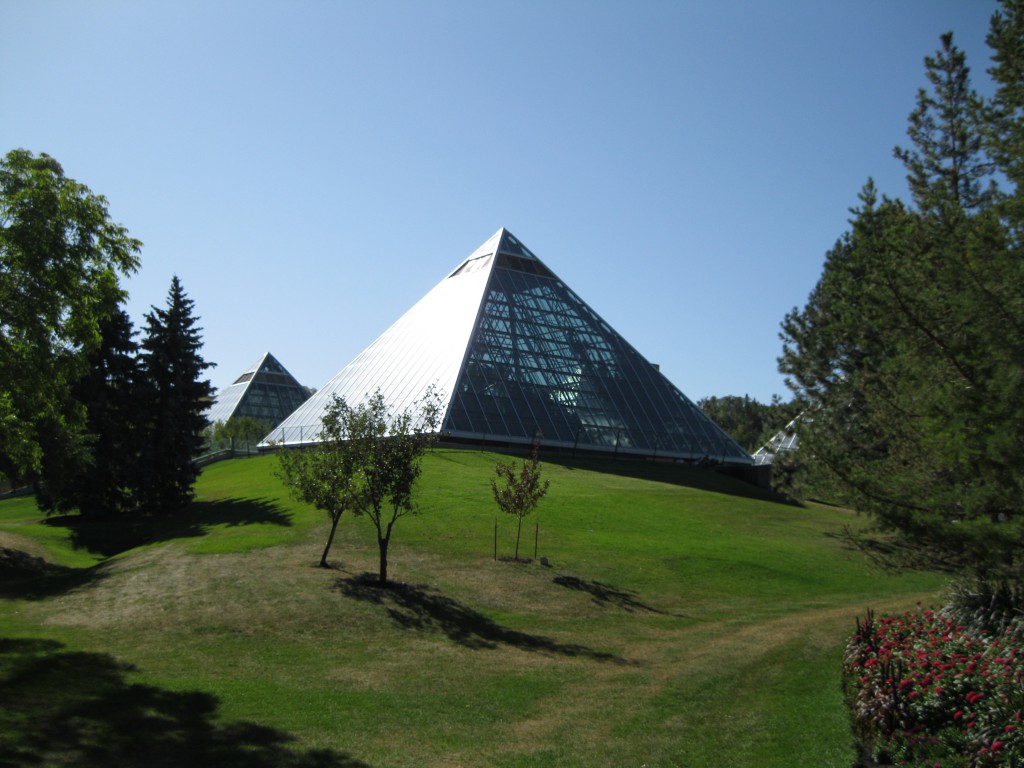
These pyramids are also a bit reminiscent of the pyramid outside the Louvre in Paris and are based on a cool spot in the heart of the river valley. You can take some great shots here of the pyramids with the city skyline in the background or just of the pyramids themselves from all sorts of angles.
Edmonton City Centre
Edmonton City Centre is located in the heart of Downtown and was established in 1974 and is a really cool four levelled shopping. There is a nice buzz in this modern mall with all sorts of shops and possibilities and having a meal.
After a long day of walking around exploring the city, the mall is a nice place to go visit and have a chill. It could also be a great pit stop during the day if you want to have a breather or want to check out one of the shops.
Craft Beer Market
If you are up for some great craft beer and a good meal, then you should check out the Craft Beer Market at 10013 101A Avenue. During the summer period they have a nice patio, located three storeys above street level, where you can experience what they have to offer.
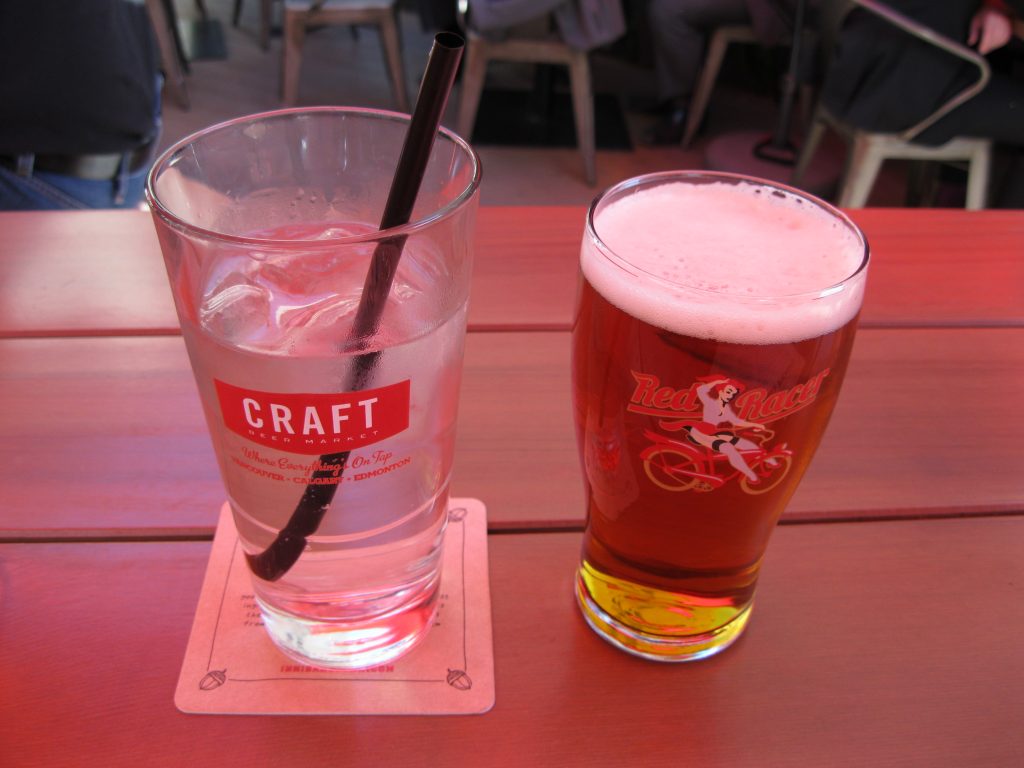
The atmosphere is nice and cosy in a relaxed classy setting among plank floors, table umbrellas and friendly staff with an awesome view of the neighbouring high rise buildings. It’s a really cool place and the quality of the food and beer is excellent at reasonable prices. They have a massive selection of beer and the Red Racer is a great choice to accompany your meal.
Manulife Place
There is a lot of nice skyscraper architecture in Edmonton. Manulife Place is a great example located at 10180 101 Street NW. This 36 storey glass tower was completed in 1983 and is the second tallest building in town at 146 metres (480 ft). It has an unorthodox exterior which can accommodate 32 corner offices per floor and the architectural style is Modernism. This is one of the buildings which is a part of the Pedway network and is connected to the Edmonton City Centre.
The Fairmont Hotel Macdonald
The Fairmont Hotel Macdonald at 10065 100 Street opened in 1915 and was restored in 1991. It is one of the most luxurious hotels in town and is located on a perfect spot overlooking the North Saskatchewan River Valley. Steel and reinforced concrete form the skeleton of the hotel which have been covered by Bedford Indiana limestone and sheet copper roofing.
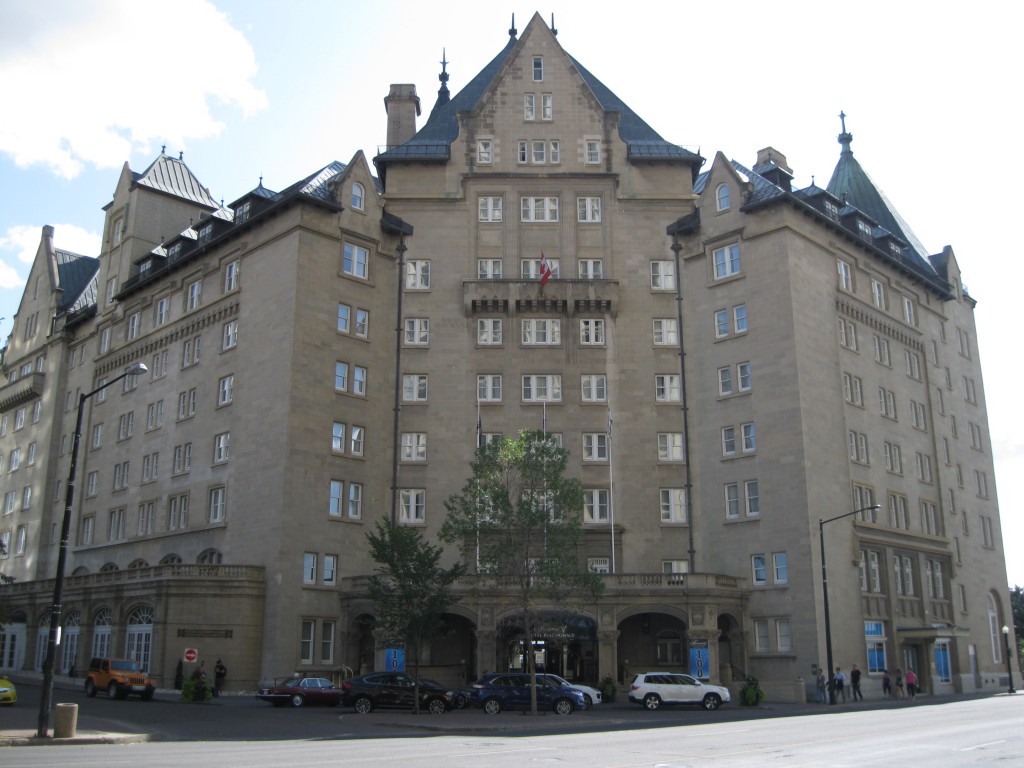
It’s a chateau style hotel with elements of French Renaissance architecture with turrets, finials and high-pitched roofs, arcades and corbelled balconies are the main features. Nicknamed the Mac, it has been known as the elegant and most popular hotel in Edmonton and was restored in 1991.
Boyle Street
If you walk down Jasper Avenue towards the Boyle Street neighbourhood you will see several cool historic buildings which are definitely worth checking out. The neighbourhood is based immediately to the east of Downtown. One of highest concentrations of old historic buildings in town are found here, even though a fair bit of structures were destroyed during the 1970s to make way for newer development.
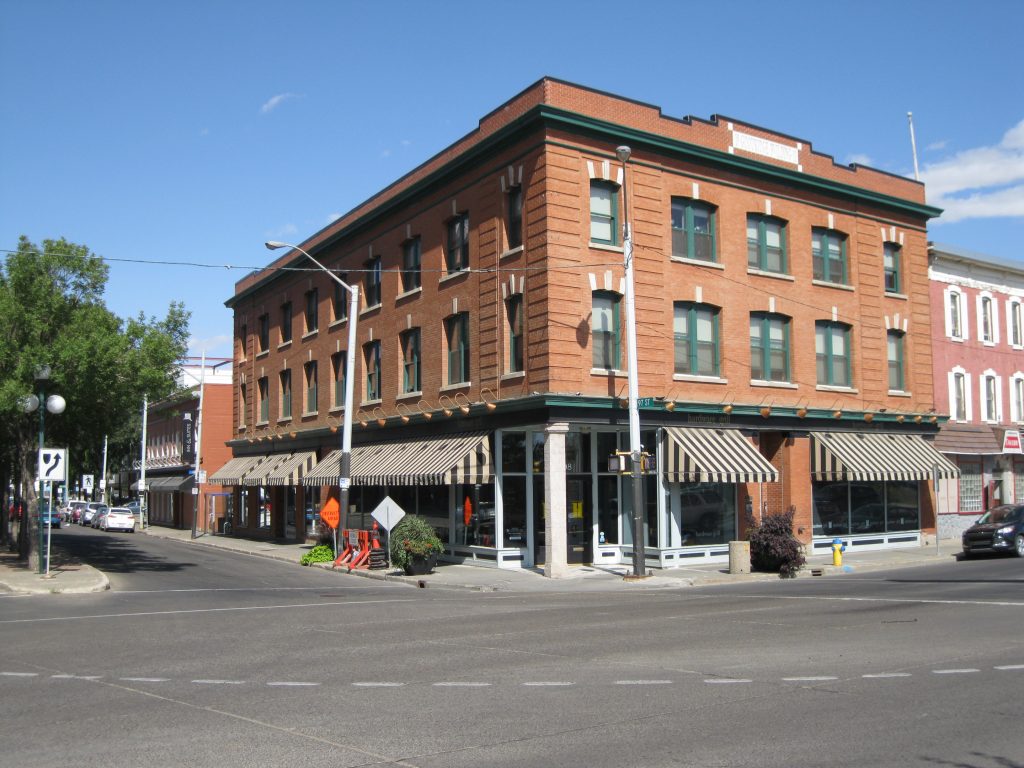
Most of the rectangular blocks and straight streets were created when Edmonton was a newly established town in 1892. The Edmonton Settlement had been divided into townships and river lots and the grid pattern of Boyle Street conforms to the boundaries of river lots.
The Hudson’s Bay Company Reserve was based directly opposite Fort Edmonton and they forced the town to spread to the east away from the fort. Today Boyle Street borders the central business district.
The Ramsay Heights Lookout
Ramsay Heights Lookout is a really beautiful spot in town. Here you’ll have a magnificent view of a bend in the North Saskatchewan River that forms the shape of a horseshoe. It’s one of the best vantage points in town.
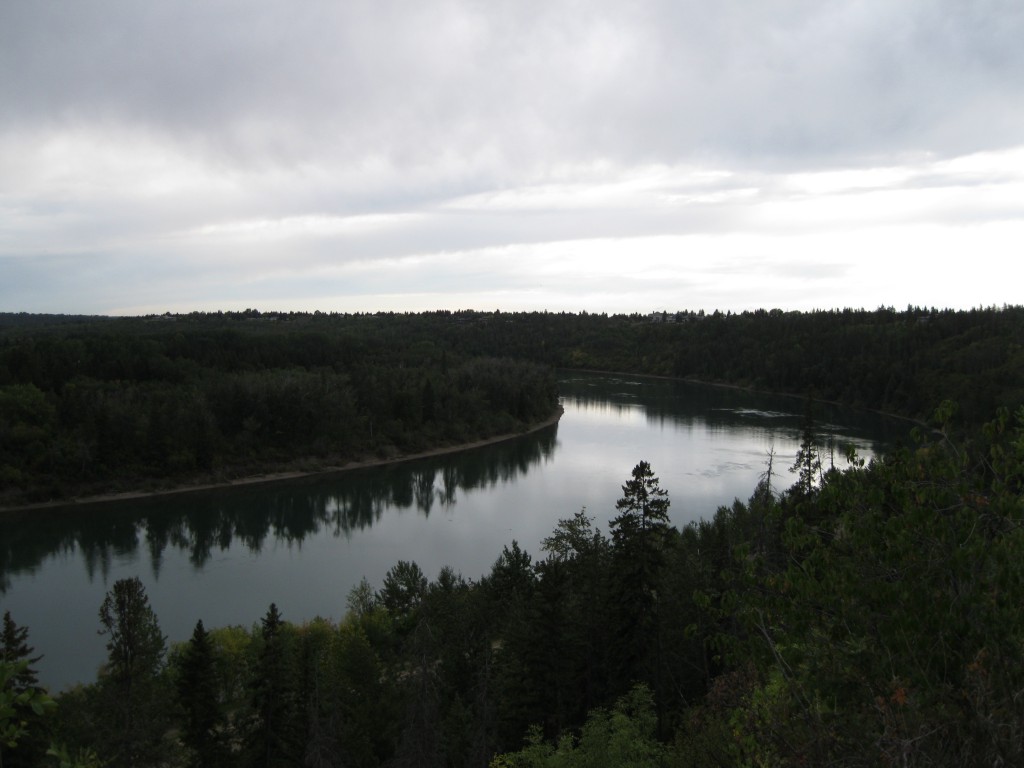
The lookout is located in the neighbourhood of Ramsay Heights south west of Downtown facing the river. The area was subject to a landslide in 1999 that destroyed 30 houses where 3 were adjacent to the river. Ramsay Heights has recovered and homes in area are in high demand in spite of the potential risk of landslides.
The Alberta Legislature Building
The Alberta Legislature Building is another highlight. In Europe buildings with domes indicates religious significance. In North America domes are often used for governmental properties and the Alberta Legislature is a prime example of this design.
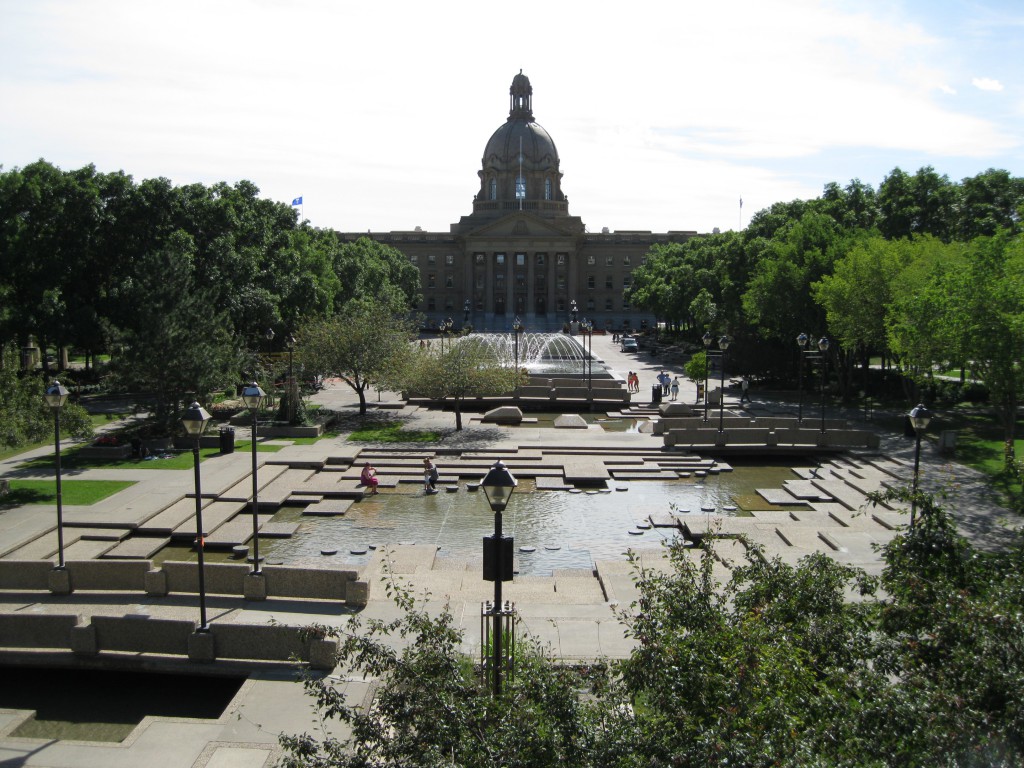
Architect A.M. Jeffers decided to make a T-shaped plan and a Beaux-Arts façade. The entry has a columned portico, paired columns for the wings and large dome with cupola. The steel frame dome is clad in terracotta. Calgary sandstone is used for the exterior with marble from Italy, Pennsylvania and Quebec. It took six years to construct the legislature and was completed in 1913.
The building is overlooking the North Saskatchewan River on the former location of Fort Edmonton V at 10800 97 Avenue NW. In front of the building, going all the way from 99 Avenue, there are fountains and pool, close to the building, where people can take a dip. This gives the area a pretty nice atmosphere and it a really cool and unusual feature to have in front on a government building.
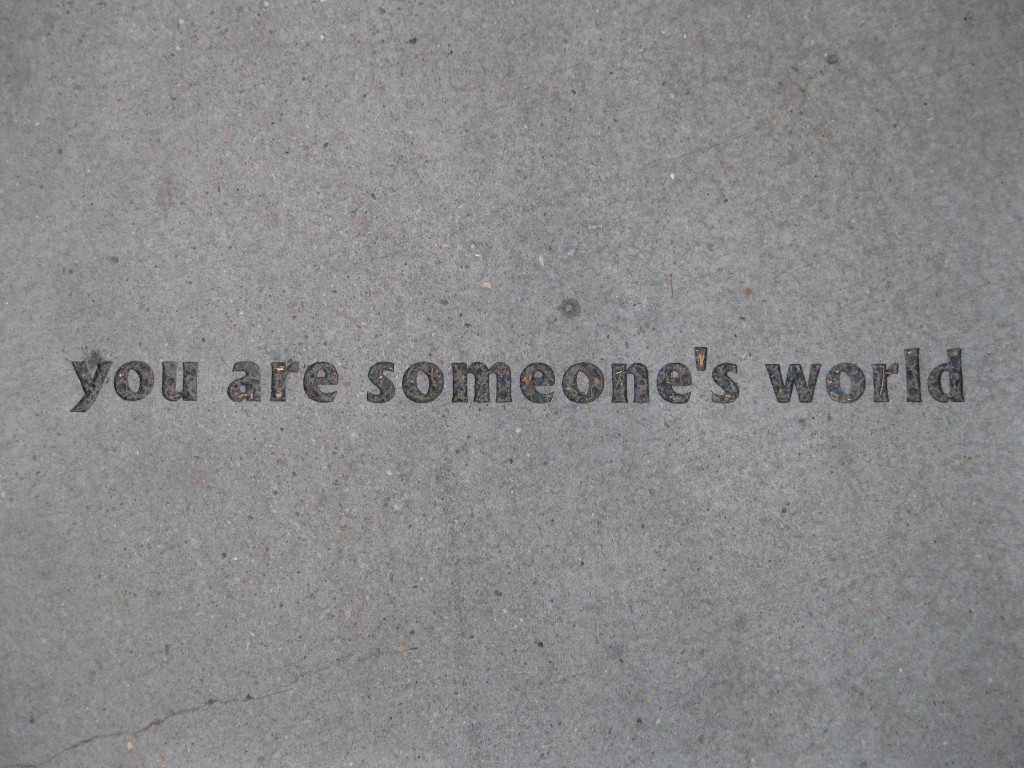
Towards the river a small wonderful park is based in front on the building. Here you will find the Centennial Flame which was lit to commemorate a hundred years of confederation in 1967. The park also as has beautiful floral decorations. A bit further down towards the High Level Bridge there is a plague marking the northwest corner of the palisade surrounding Fort Edmonton V.
The High Level Bridge
High Level Bridge is located just around the corner from the Alberta Legislature Building and spans across the North Saskatchewan River, connecting Edmonton and Strathcona via 109 Street which were, as mentioned earlier, two separate cities back in the day. You can drive across but there are also lanes below street level for walking and biking. When crossing the bridge you will have some great views of the skyline and the football fields below.
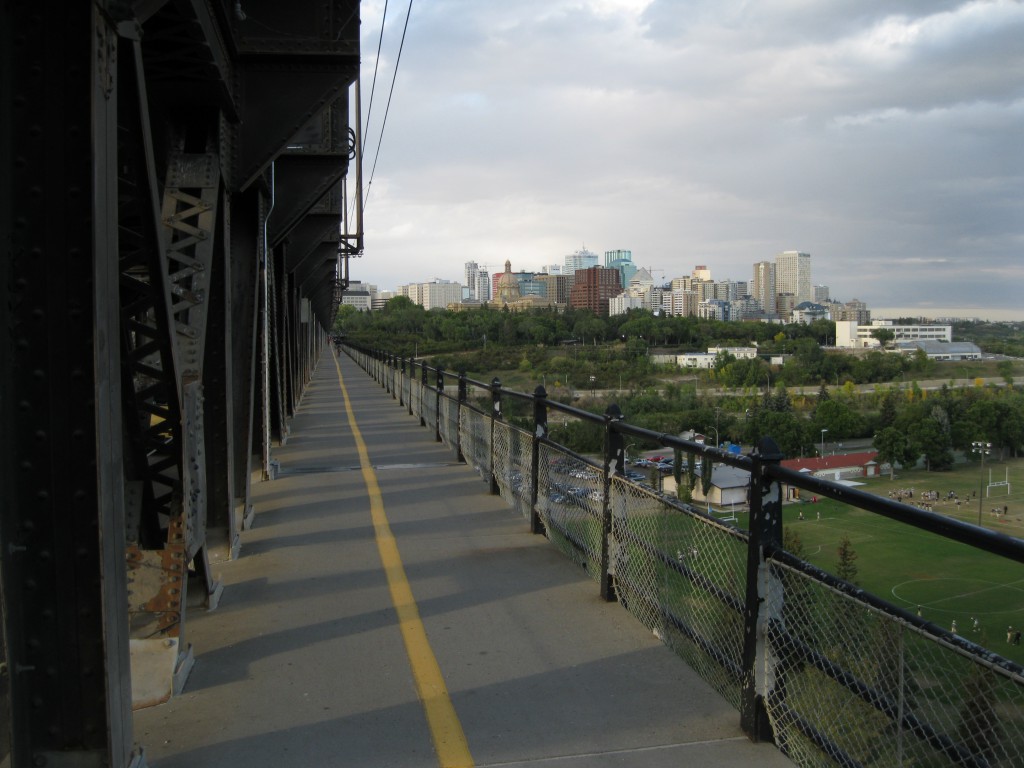
If you are walking towards Downtown on the right side of the bridge, note the cool quotes on the ground which are “reflections contributed by Braemar High School students”. These are found when you enter Downtown at the end of the bridge. Most of them are really clever, cute and quite brilliant.
Garneau
If you’ve crossed the river from Downtown to explore Old Strathcona you could go down to Saskatchewan Drive during your excursion and check out some of the cool residential buildings in the Garneau neighbourhood. You will also have a great view of the city skyline overlooking the Waterdale Park.
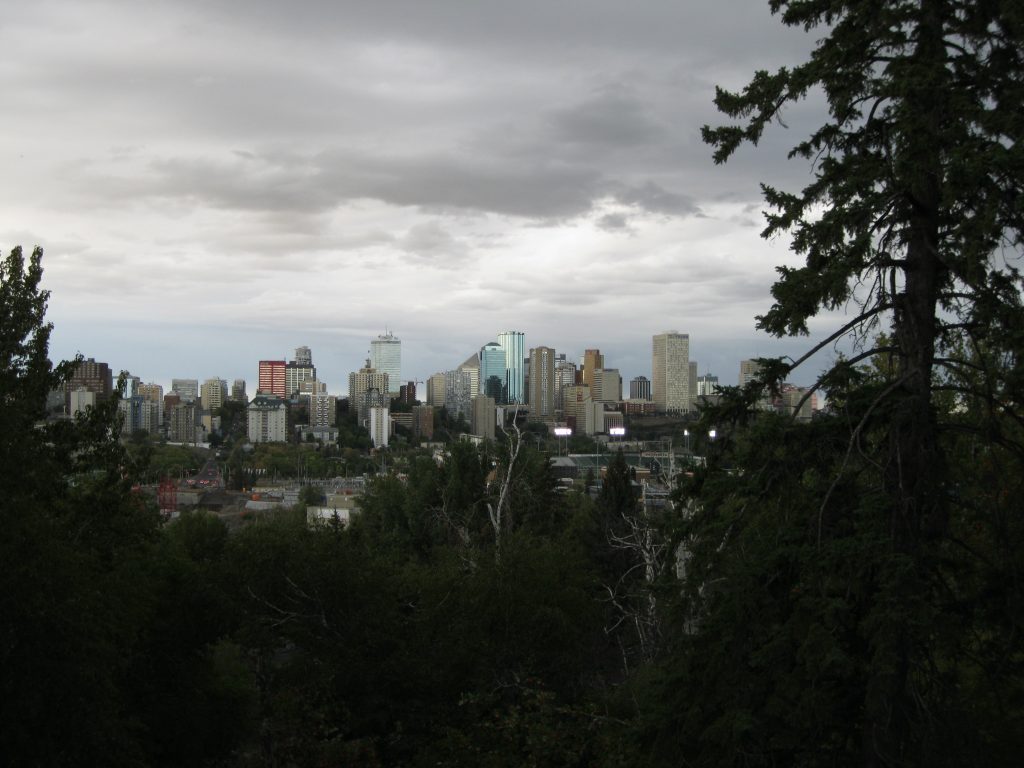
As you walk down Saskatchewan Drive you will have different vantage points of the skyline, so you’ll get to see it from several different angles. Garneau is based just to the west of Strathcona.
The Fascinating Old Strathcona
A really interesting area of the city is Old Strathcona. This is a hip little neighbourhood with small independent shops and cool cafés. It’s a bit reminiscent of Haight-Ashbury in San Francisco and Williamsburg in Brooklyn, New York as it’s got that eclectic, alternative and hippie vibe to it. It’s a great spot for people watching. Very cool.
If you are staying in the city you can cross the High Level Bridge by foot to get there. The area is based around 82 Avenue also known as Whyte Avenue. The most interesting part of Old Strathcona is between 109 Street and 103 Street and 82 Avenue/Whyte Avenue and 85 Avenue.
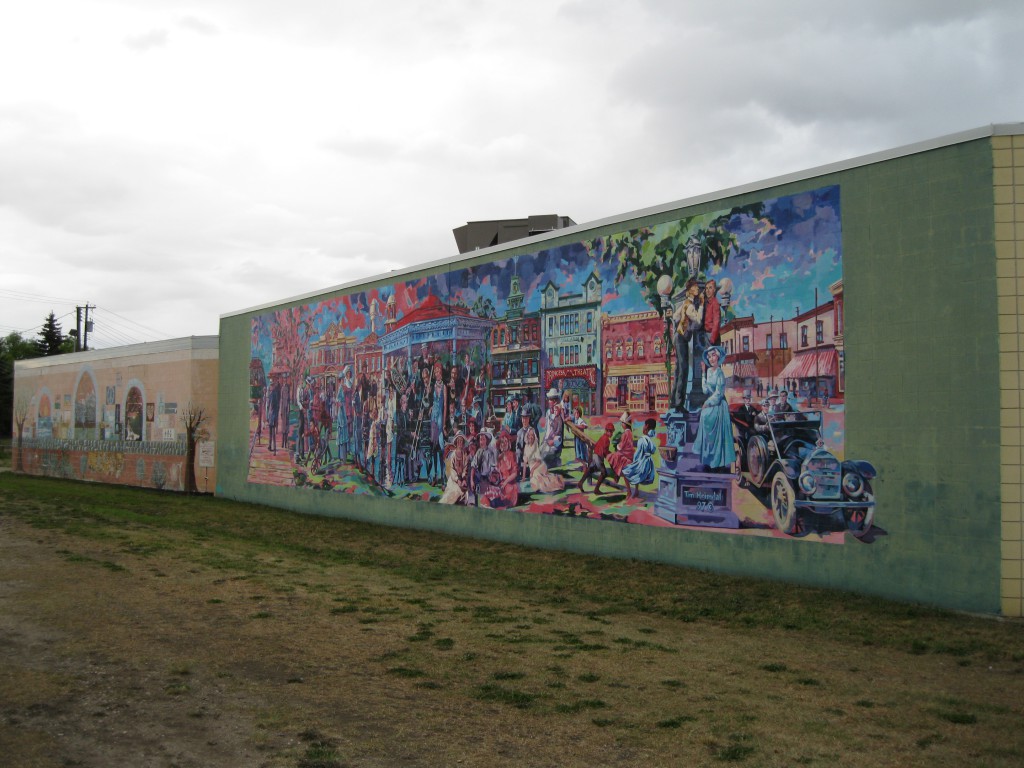
On the corner of 83 Avenue and 103 Street you will find the Old Strathcona Farmers Market. A lot of the cool cafés and shops are based on Whyte Avenue and 103 Street. There is a fair bit of interesting old architecture and murals in the area which you should definitely explore
Early constructions were mainly of wood and Whyte Avenue was dominated by primitive shack homes and quickly built pioneer homes but within a few years these were replaced by more substantial wood frame structures.
In 1902 a bylaw was passed dictating that future structures should be brick buildings to avoid massive fires. Most of the current brick buildings were constructed between 1910 and 1912 where a lot of settlers arrived mainly from Eastern Canada, the United States and Europe.
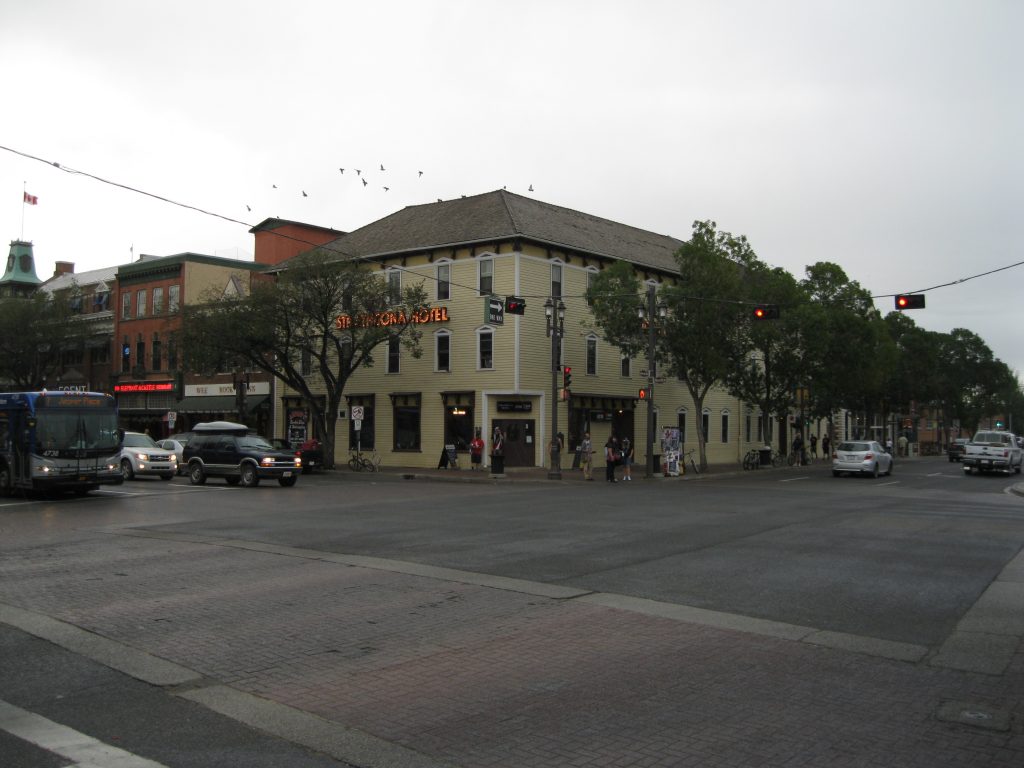
Present day Old Strathcona used to be the commercial core of the former city of Strathcona. The neighbourhood is now the heart of Edmonton arts and entertainment scene. The area is also pretty popular among students from the University of Alberta which located not too far away.
Have a chill at one of the cafés with a cup of coffee and a slice of cake and take in the atmosphere. This is just one of those places that is great for people watching. Some of the cafés here are quite classy and an awesome hang.
The Beautiful Murals
As mentioned earlier you will find some very neat murals as well in Old Strathcona. They are pretty impressive. There are more than 30 murals on various buildings, all created as a part of Edmonton’s centennial in 2004 to celebrate the artistic community in town which have been encouraged.
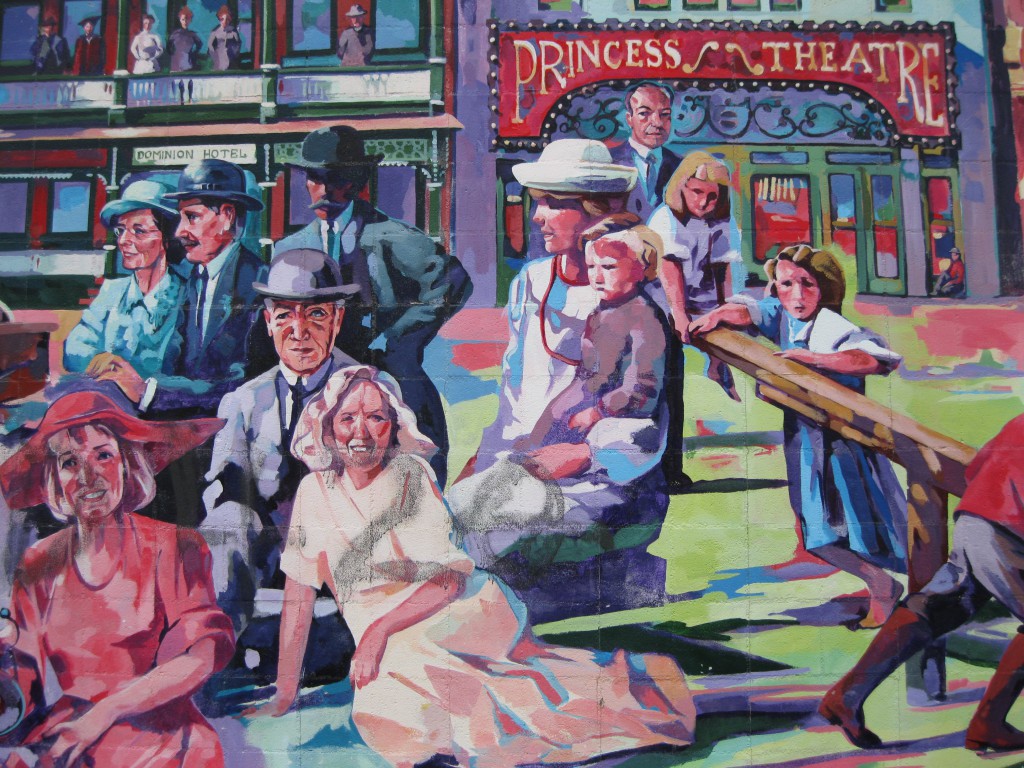
When you explore this unique neighbourhood you will feel the positive vibe these wonderful murals bring to life.
The Strathcona Hotel
The oldest building is the Strathcona Hotel at 10302 82 Avenue. It was built in 1891 when the railroad arrived. It was a stopover for many immigrants arriving in the day to establish homesteads of business in the northwest. It is known as the oldest building with a wood frame commercial structure in the region and is one of the last hotels in Alberta with this structure from the 19th century. It’s a great example of commercial frontier architecture.
Strathcona Fire Hall No. 1
At 10322 83 Avenue the Strathcona Fire Hall No. 1 is located which is a two story brick building constructed between 1909 and 1910. Features that stand out are the arch vehicle doors facing 83 Avenue and the bell tower. It is one of the oldest major fire halls in Alberta and one of the oldest buildings in the Old Strathcona Historic District. It is also a perfect example of fire hall architecture of the 20th century.
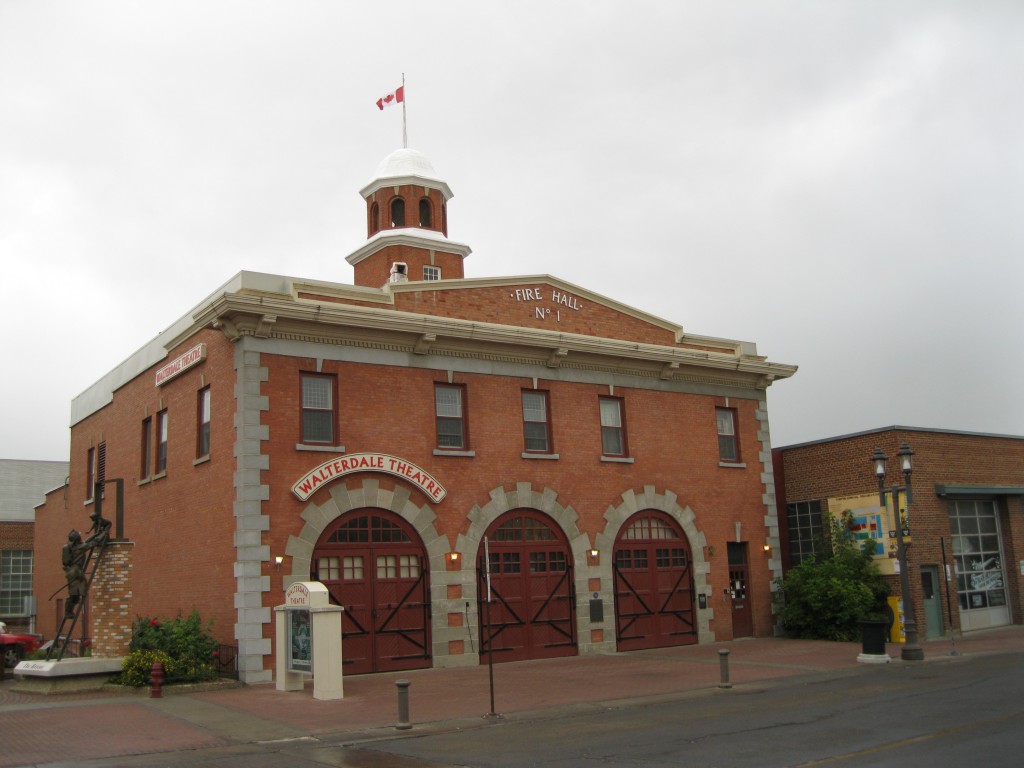
After the amalgamation of Strathcona and Edmonton in 1912 it was renamed Edmonton Fire Hall No. 6 and functioned as a fire-fighting facility until 1954. Thereafter it was used for storage until 1974 where the Waterdale Theatre Group could call it home. Since then it has been a part of the exciting theatre scene of Old Strathcona. There is still a sign on the front of the building saying “Fire Hall No. 1” along with a sign for Waterdale Theatre above one of the arches and another on the side of the structure.
The Connaught Armoury
At 10310 85 Avenue you will find an interesting old historic building from 1911 called the Connaught Armoury which is a two storey rectangular brick building. It is the oldest existing armoury building in Alberta and has a long history of early military activities in the province as it was a strategic base after the Alberta Mounted Rifles were established in Edmonton and Strathcona in 1905. The Alberta Mounted Rifles were redesignated as the Alberta Dragoons in 1911.
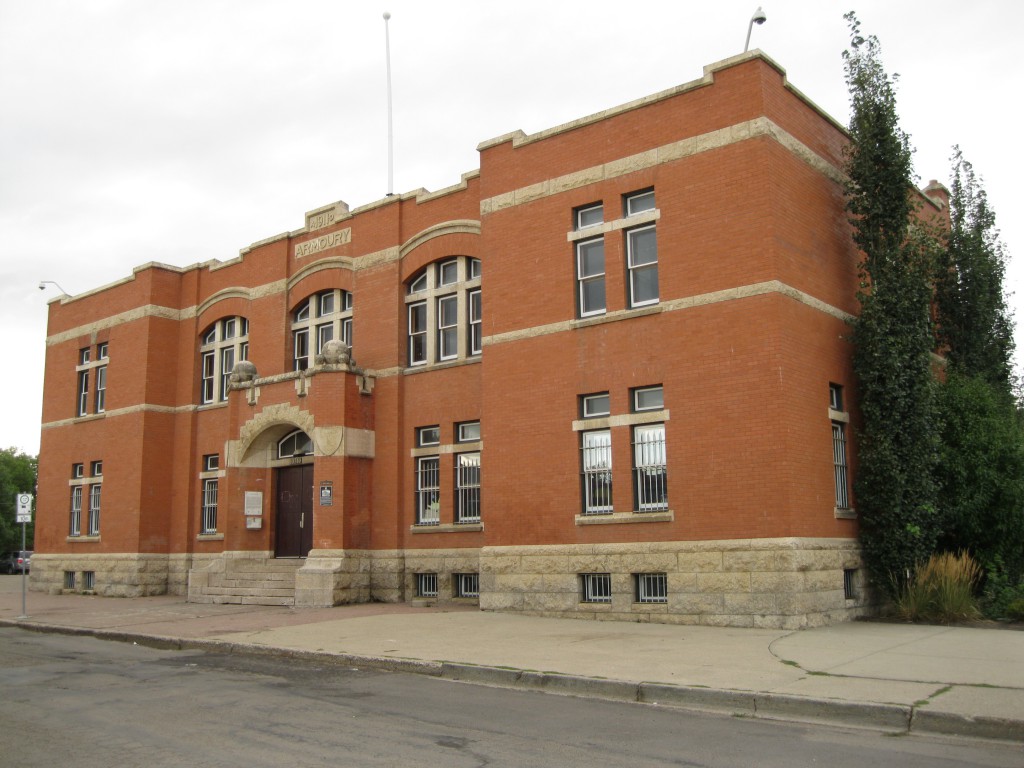
The Dragoons trained and sent soldiers to war in 1914 and in 1939. The Armoury continued to service the military until 1965 where the regiment was disbanded and the building was sold to the city. It also stands out as a great example of the particular type of architecture associated with military in the early 20th century.
